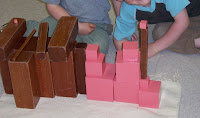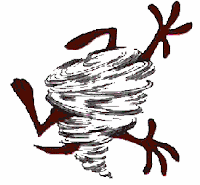Ever had one of those days? Thursday of this last week was a doozie! At first, I wasn't sure I wanted to write about it. Will readers understand that even with the best intentions, things can go in directions never considered? Then I read about another teacher's Thursday over at montessorimatters and decided there MUST have been something in the air that day.
Thursday started like any other day. I woke up at 5, fed the cats, made the coffee, ate my breakfast, made my lunch, had a shower, dried my hair and woke the rest of the family. I was just deciding whether or not to iron a particular shirt when the phone rang.
It was the teacher from the other primary (preschool) classroom.. She was ill and wouldn't be in which meant that in order to fulfill the provincial licensing requirements, we would have to reshuffle the staff and the children – never a particularily good solution but Montessori substitutes are few and far between. Our assistant went to help in the other classroom, a few of my children went into the elementary classroom and I stayed (alone) in my classroom with 15 children.
Everything went just as any established Montessori room should. That is, everything went well until around 10:30. Just as a child arrived late from a doctor's appointment, false fatigue set in. Now I know that during false fatigue, I am not to interfere – to trust the method and the children will settle. However, I am also pretty clear on what kinds of behaviour should be stopped (interfered with).
The late child could not settle down and was disturbing everyone he came in contact with so I took him, gently, by the hand and asked him to stay with me for a minute or two. That's when one little girl (we'll call her Alice), just back from a two week trip away, decided to pick up the pom poms that another child (Betty) had scattered as part of the sweeping activity. Alice was popping the pom poms into her mouth then spitting them into the garbage. Betty asked Alice several times to stop and finally asked me to help. Over I went to redirect Alice.
While helping Alice pick pom poms out of the garbage, one of our 5 year old boys discovered that the construction of our button frame lends itself beautifully to being put over one's arm and used as a sheild. Immediately, another 5 year old picked up a pencil and brandished it like a sword. By the time I got to them (because I try NOT to run across the classroom) the "battle" was full on and there were several pencil marks on the back of the dressing frame.
Once the boys were settled with an eraser and working to get the pencil marks off the button frame, I turned to look for Alice. She had retreived all the pom poms out of the garbage and had returned to her sewing work. I quietly moved closer to observe her. That's when I noticed a strange substance all over the floor around her table. It didn't take me long to realize that she'd been practicing her cutting skills on the pin cushion and had discovered all the lovely sawdust inside. A sweeping lesson ensued.
While the sawdust was being cleaned up, one of our youngest children moved too quickly at the snack table and bumped three plates onto the floor with a resounding crash! Again, I calmly walked over to the broken dishes with a dustpan and whisk broom – completely aware that several pairs of eyes were following my every move – and carefully swept up the shards of glass.
Thankfully, by then, it was time to call the children together to get ready to go into the playground. That's when the Principal came into the room and reminded me that I was teaching Art in the elementary class that afternoon.

Great! I'd forgotten and had nothing prepared. Since we are making a life sized Dragon head for the Spring Presentation (more on that another time) I spent my lunch break running around cutting chicken wire, mixing flour and water, and cutting up newsprint.
The afternoon went very well so we decided to clean up the Elementary classroom and go outside for the rest of the afternoon. That's when it happened. As the elementary children were putting the chairs up on the tables, one chair got knocked off, somehow swinging around to smash into the side of the turtle tank. Several litres of water (felt like thousands) , sand and turtle came flooding out across the floor and the children scattered.
Now here is the good part. The oldest children (three girls of 10 & 11) immediately flew into action. One of them picked up the turtle, another found a bucket, while the third herded all the younger children out into the hall. Once the turtle was safe, two of the girls found mops and buckets and began to soak up the water. The third girl got on the telephone and called her mother to bring in an empty fish tank they had at home.
By now it was home time but the room was still awash. No problem! The older girls picked up the younger children one by one and carried them across the room to get their coats and backpacks. Then they carried them back again to get their outside shoes on. Honestly, I could have made myself a cup of tea and put my feet up!
To make a long story a little shorter, the new tank arrived, many parents and another teacher stayed around to help and by 3:30, everything was sorted and back to normal.
I wonder what next week holds in store?

 As for misusing materials and furniture, this should be stopped immediately. Taking a child by the hand and having him stand with me while I work with another is one method of halting inappropriate behaviour. Another is to invite the child to go for a classroom walk with me until he finds something interesting to do. On occasion, I have suggested a child go outside and dig eggshells into the garden or fill the birdfeeder. I have even opened my arms wide and enveloped a child in a great big hug. Keep in mind, however, that whatever method I choose comes from my relationship with the children. A hug may refocus one child only to aggravate another.
As for misusing materials and furniture, this should be stopped immediately. Taking a child by the hand and having him stand with me while I work with another is one method of halting inappropriate behaviour. Another is to invite the child to go for a classroom walk with me until he finds something interesting to do. On occasion, I have suggested a child go outside and dig eggshells into the garden or fill the birdfeeder. I have even opened my arms wide and enveloped a child in a great big hug. Keep in mind, however, that whatever method I choose comes from my relationship with the children. A hug may refocus one child only to aggravate another.


 An interesting occurrence that takes place in Montessori classrooms is false fatigue. This is something that often happens about 1 to 1.5 hours into the morning provided there has been a period of focussed work beforehand. Almost as though on signal, most of the children seem to finish their work, behaviour becomes disorderly, and the noise level rises. However, if the teacher does not over-control at this point, the children will return to work by themselves and that work will be at an even higher level than before. By anxiously stepping in and 'managing' at this point, teachers replace the child's will with their own. In fact, interference will actually prolong the period of false fatigue. Difficult though it may be, during false fatigue, a teacher must step back and trust both the method and the children. "If in the period of 'false fatigue', at 10am an inexperienced teacher, interpreting the phenomenon of suspension or preparation for the culminating work as disorder, intervenes, calling the children to her, and making them rest, etc., their restlessness persists, and the subsequent work is not undertaken." (Montessori) False fatigue is a requirement in order for the children to return to a higher level of focus and concentration.
An interesting occurrence that takes place in Montessori classrooms is false fatigue. This is something that often happens about 1 to 1.5 hours into the morning provided there has been a period of focussed work beforehand. Almost as though on signal, most of the children seem to finish their work, behaviour becomes disorderly, and the noise level rises. However, if the teacher does not over-control at this point, the children will return to work by themselves and that work will be at an even higher level than before. By anxiously stepping in and 'managing' at this point, teachers replace the child's will with their own. In fact, interference will actually prolong the period of false fatigue. Difficult though it may be, during false fatigue, a teacher must step back and trust both the method and the children. "If in the period of 'false fatigue', at 10am an inexperienced teacher, interpreting the phenomenon of suspension or preparation for the culminating work as disorder, intervenes, calling the children to her, and making them rest, etc., their restlessness persists, and the subsequent work is not undertaken." (Montessori) False fatigue is a requirement in order for the children to return to a higher level of focus and concentration.

 Great! I'd forgotten and had nothing prepared. Since we are making a life sized Dragon head for the Spring Presentation (more on that another time) I spent my lunch break running around cutting chicken wire, mixing flour and water, and cutting up newsprint.
Great! I'd forgotten and had nothing prepared. Since we are making a life sized Dragon head for the Spring Presentation (more on that another time) I spent my lunch break running around cutting chicken wire, mixing flour and water, and cutting up newsprint.
